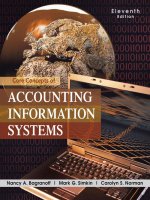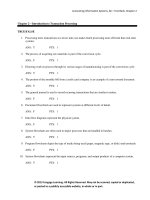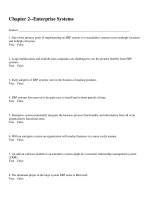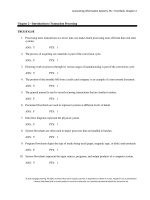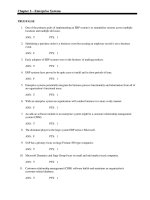Accounting information systems ch14
Bạn đang xem bản rút gọn của tài liệu. Xem và tải ngay bản đầy đủ của tài liệu tại đây (2.58 MB, 36 trang )
Human
Resources
(HR)
Management
and Payroll
Process
1
Learning Objectives
• Know the definition and basic functions
of the HR management and payroll
processes
• Recognize the relationship between the
HR management and payroll
processes and their environment
• Comprehend the relationship between
the HR management and payroll
processes and management decision
making
• Understand the logical and physical
characteristics of the HR management
and payroll processes
• Become familiar with some of the
technology used to implement the HR
management and payroll processes
• Know some of the plans commonly
used to control the payroll process
HR
Management
and
Payroll
Processes
2
HR/P Spoke in the AIS Wheel
•
•
•
•
In this chapter, we spotlight the
human resources (HR)
management and payroll
processes.
It will become clear later why
we depict these processes
with one spoke in the AIS
wheel
We will describe the various
users of the HR management
and payroll processes, each
having their own view of the
enterprise system and
enterprise database
In addition, we will analyze the
process controls related to the
payroll process
3
Synopsis
• Human capital management (HCM), the
process of managing how people are hired,
developed, assigned, motivated and retained,
presumes that employees reflect a strategic
investment, rather than an administrative cost
• Some estimates place the value of human
capital between $500,000 and $5 million per
person
• Costs of such human capital, including
compensation, benefits, and HR, represent 43
percent of the average corporation’s total
operating expense
4
Synopsis
• The automation of HR (dubbed “e-HR”) may
transform HR from a cost center to a highly valued,
strategic, mission-critical part of the business
• HR automation will affect evaluation and
compensation programs to reflect the changing
work patterns, including:
–
–
–
–
–
–
graying workforce
virtual teams
telecommuters
consultants
contractors
part-time and temporary employees
5
Synopsis
•
In this chapter we explore three themes:
1. First, we briefly examine the importance of
people to the success of any organization
2. Next, we describe how the HR management
and payroll processes assist management in
leveraging its human capital
3. Finally, we introduce some of the technology
used to implement modern HR management
and payroll processes
6
Process Definition and Functions
•
•
•
Personnel management started by handling payroll and
personnel administration, but evolved by adding functions
to handle recruiting, employee relations, and so on.
HRM still viewed personnel as something that could be
controlled
HCM philosophy is based on three major principles:
1. An individual’s value to an organization is derived from his/her jobrelated knowledge, skills, attitude, and motivations
2. Human assets include full-time permanent employees, plus parttime employees, temporary employees, and independent
contractors.
• With supply chain management, an organization’s human
assets could include employees of suppliers, sales channel
partners, and customers
3. A person’s relationship with an organization, from hiring through
termination, must be nurtured and managed to obtain maximum
lifetime value
7
Definition of HR Management Process
• Primary function of the HRM process is to create
information flows that support the following:
1. Repetitive work routines of the HR department
2. Decision needs of those who manage the HR
department
• The HRM process supports the work routines of
the HR department and provides information for
management decisions by:
– Capturing, recording, and storing data concerning HR
activities
– Generating a variety of HR forms and documents
– Preparing management reports
– Preparing governmental reports
8
The Payroll Process
• Many companies often merge payroll and HR
• The payroll process maintains records of payroll taxes, fringe
benefits, attendance/absence, time worked and employee
paychecks
• The payroll process is generally automated because
computers are much faster at handling the repetitive
computations necessary (payroll is also the most frequently
outsourced application in accounting)
• Current HR software reaches far beyond simply doing payroll
and includes:
– Benefits admin, applicant tracking/processing, skills inventories and
compliance reporting
• Much of HRM is NOT captured by GAAP
– But accountants must recognize the immense value of human capital
and its affect on the long-term financial health of the organization
9
Payroll Part of HR Module
• It is common for
payroll to be part of
the HR module in
software (SAP
example)
10
Figure 14.1 on page 512
• The HR module includes options for both HR and
payroll, among others
• The advantages gained by allowing the two
processes to share common data include:
–
–
–
–
–
–
Creating a single source for obtaining HR information
Providing for faster data access
Minimizing data redundancy
Ensuring data integrity and consistency
Facilitating data maintenance
Improving data accuracy
11
Organization Chart of the HR Function
12
Duties of HR Managers
13
Duties of HR Managers
14
Technology Trends and Developments
• HR self service systems
• Organizations might outsource other functions to support
HR management processes.
– Web-based collaboration
– Payroll
• Enterprise systems play a major role in implementing
required HR and payroll functionality.
• Implementing the HRM process with an enterprise
system can help recognize the benefits of integration of
the HR management process with other enterprise
systems modules such as:
–
–
–
–
Financial Accounting
Logistics
Sales and Distribution
The Workflow Module
15
Implementing the HRM Process
• Process Inputs: In general, the HR forms in the
figure capture information about three HRrelated events:
• (1) selecting employees
• (2) evaluating employees, and
• (3) terminating employees
16
Implementing the HRM Process
•
Selecting employees may be initiated in one of
two ways:
1. Departmental managers (outside the HR
department) may initiate the process to
satisfy their immediate hiring needs
2. Selection process may be started by the
system automatically
17
Implementing the HRM Process
•
Evaluating employees comprises a multitude of
activities
– Departmental managers and supervisors
(again, outside the HR function) usually
initiate evaluations or other changes affecting
employees
– The manager of personnel appraisal and
development (in HR) typically approves the
review and implements such changes
18
Implementing the HRM Process
•
Terminating employees closes the employment
process loop
– Periodically, departmental managers and
supervisors (in concert with HR managers)
must make difficult decisions about the
retention of employees
– If a termination is necessary, the employee
change screen is used to initiate the process
of changing an employee’s status from
current employee to terminated employee
19
Implementing the HRM Process
•
•
•
•
•
Processing Logic and Process Outputs.
HR requests initiated outside of the HR department are approved
within that department and then routed to HR for approval
Some data may be entered within HR
The employee/payroll master data, skills inventory data, and laborforce planning data within the enterprise database are updated and
various reports are made available
Several outputs are produced
– New hire:
• An employment letter is sent to the employee
• Selection notice is sent to the department manager
– Feedback on job performance:
• Employee review form
– Termination:
• Employees are notified of a dismissal through a dismissal letter
• Termination notice sent to the operating department manager.
20
Implementing the HRM Process
•
HRM process prepares reports for government and nongovernment entities
–
•
HR reports might include those provided to the following:
–
–
–
–
•
• Unions
• Equal Employment Opportunity (EEO)
• Occupational Safety and Health Administration (OSHA)
• Department of Labor
There are also numerous communications to employees of HRrelated information
–
–
–
–
–
•
Payroll reports: employee federal, state, and local taxes
Job opening announcements
Training information
Phone books
Benefits literature
Policy and procedure manuals, and the like.
Many companies have found that such materials can be
disseminated effectively and efficiently through an HR portal,
which serves as a central data source for such information.
21
HR Management Flowchart
22
Key Data Tables in the HR Process
• Though the flowchart shows only one data store,
multiple database tables are contained:
– Employee/payroll master data
– Labor-force planning data
• Staffing requirements
• Skills required
• Turnover data
– Skills inventory data
23
The Payroll Process
• Payroll
generally falls
under the
controller’s
office with the
treasurer
participating
in distributing
paychecks
24
Payroll Process Context Diagram
25

